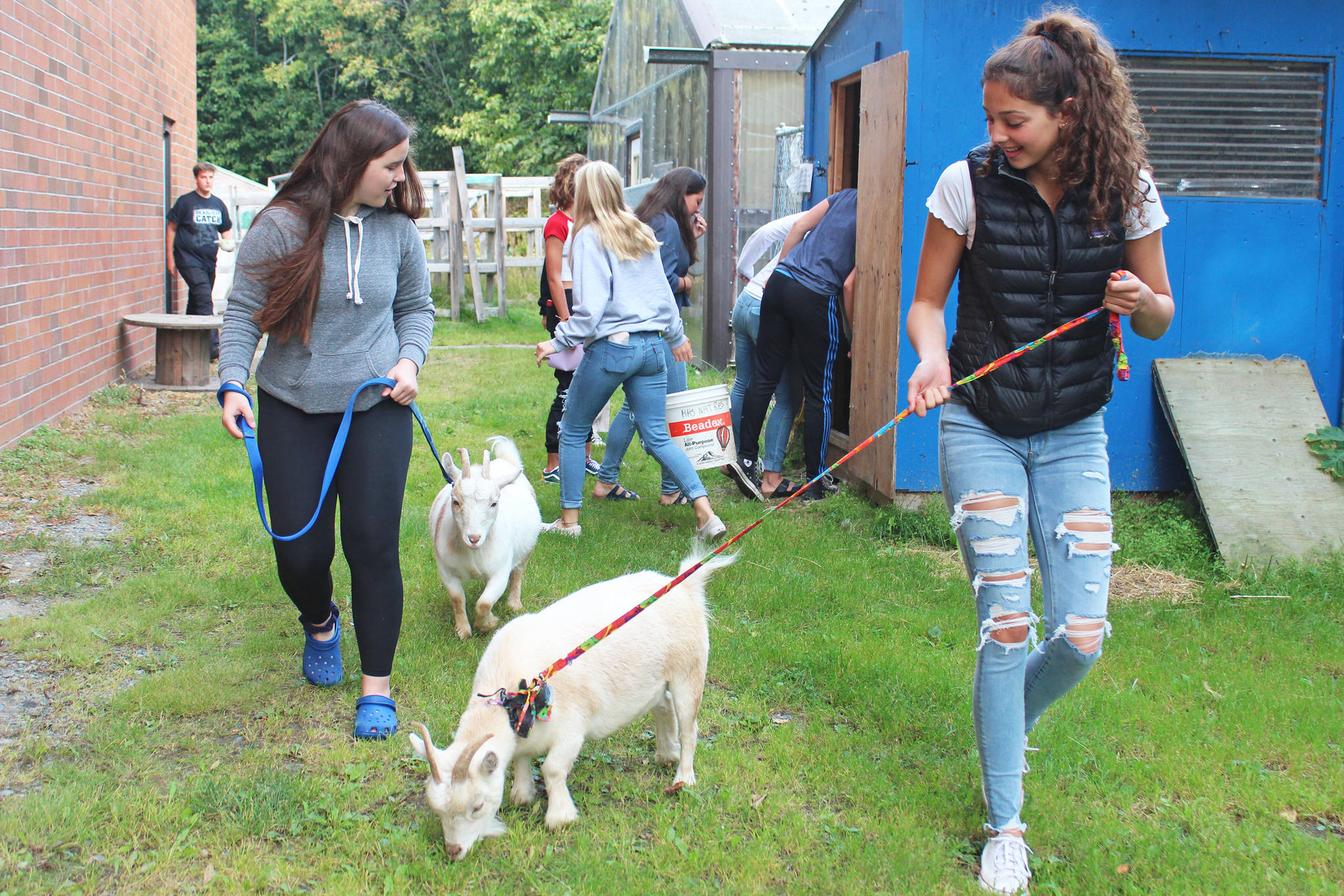People know exactly how to get to Homer High School’s football field and the Alice Witte Gymnasium. The Commons is often used for community events. But not many people know that, tucked behind the school around the corner from the entrance to the pool, is a greenhouse teeming with life each year and several animals living out their lives with high school students as their caretakers.
Kendra Nelson has an intimate knowledge of the school’s greenhouse and animals since taking over Homer High’s natural resource technology class from Francie Roberts three years ago. She can now answer most questions about the large industrial room that opens to the outside of the school and leads to the greenhouse, the dust situation in that greenhouse and, perhaps most importantly, what to do if Olive is being mean to Flower.
These are the school’s two dwarf goats, who have honorary staff ID badges and got their pictures in the yearbook last year. Nelson spent the first part of a class period last Friday answering questions her students had after getting some initial looks at the class spaces and the animals.
Turns out, Olive is a bit of a bluffer when it comes to being aggressive, and Nelson told her students not to worry too much about how they behave toward each other.
“It’s in goats’ nature to butt heads and stuff,” she said. “… They’re sisters — they fight.”
The goats are just one of many moving parts Nelson coordinates in the natural resources course. The fall is devoted more to agricultural studies like planting and taking care of the animals (which also include a rabbit named Chubbs and several chickens). The students get experience with animal husbandry and even try out hydroponic growing systems in the greenhouse and classroom.
In the winter/spring semester, students learn more about natural resources like forestry, fisheries, and oil and gas. These are important topics, especially for Homer students, because natural resources are a huge part of the Alaska economy, Nelson said.
“It’s kind of a booming industry right now,” she said. “Farms are on the rise in the state of Alaska. We’re seeing more opportunities for people to get into that sector of the economy with different greenhouse programs that are available.”
As the Alaska Legislature worked on forming a state operating budget this year, Gov. Mike Dunleavy originally vetoed state funding for agriculture. About $2.4 million was later restored for spending on agriculture programs including marketing Alaska products, seed production and inspection and regulatory programs.
Each day, the students head downstairs to the natural resources room and perform daily chores. Some students are goat walkers, others need to feed the chickens or sweep the floors. Then it’s on to the larger daily exercise.
On Friday, students worked alone or in groups to prepare large garden beds that sat untouched all summer for planting. They pulled out existing vegetation, picked out rocks and tilled the soil before adding fertilizer that Nelson instructed them how to use.
The greenhouse filled with dust and students shuffled between garden beds and the water filling station. Nelson poked at some ancient-looking buttons until a vent opened and a fan began clearing the air.
Day-to-day challenges and student questions are just the beginning of her work to keep the class functioning. This summer a post appeared on the Homer High School Facebook page seeking donations of hay for Olive and Flower. This is an expensive item and eats away at the majority of Nelson’s budget for the class. She said she got an outpouring of support from the community and and offer from the Matthews Farm in Ninilchik to fill the class’s storage shed up with hay.
“We haven’t set a time to pick up hay yet, but Olive and Flower should have full bellies all winter thanks to the outpour of support,” Nelson wrote in an email.
Nelson also comes in on weekends to feed the animals. She also invites local hobbyists and experts to chat with her about agriculture and economics in order to improve her own understanding, and the class. Locals are welcome to share their skills or knowledge with her class, either as a guest speaker or with their own project, Nelson wrote in an email. They can contact her at KNelson@kpbsd.org.
“I do take student interest into consideration,” Nelson said as the class walked down to the greenhouse on Friday. “For instance, several of them said on their seed wish list that they wanted to do cactus, and so I went and bought a few cacti.”
On Friday, Nelson and a student were checking the cacti to see if they were ready for planting in soil.
The students also enjoy the work with hydroponic gardening, most likely in part because this form of growing brings results more quickly than others, Nelson said. The regular garden beds have also become more integral to the class. In years past, the City of Homer would utilize the greenhouse in the spring. However, a change in the Parks and Recreation Department has allowed the high school class to retain use of the greenhouse for those extra months, and Nelson said it’s made all the difference.
Nelson also has the students focus on reducing waste through the course. One of their projects is to find and document a way to cut down on food waste in their personal lives.
“Whether it’s sharing a meal rather than getting your own where you end up with leftovers,” she said. “(Or) if you see some produce that’s being wasted in your fridge, bring it in for the (class) chickens.”
Even if students don’t end up pursuing a career in natural resources, Nelson said getting kids growing and into greenhouses can sow the seeds for making it a hobby later down the road.
Reach Megan Pacer at mpacer@homernews.com.


